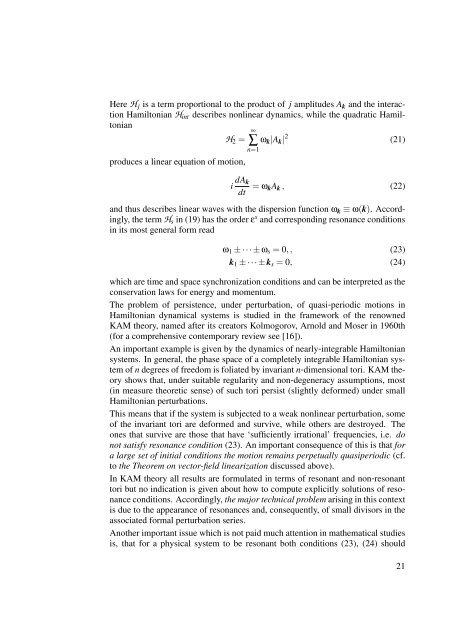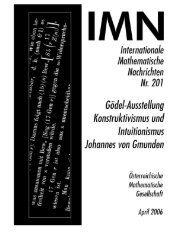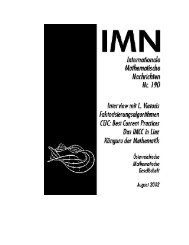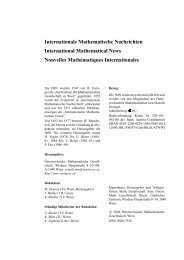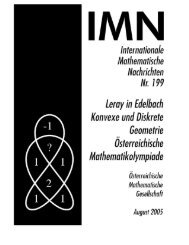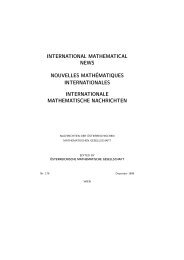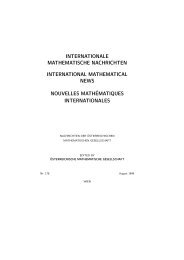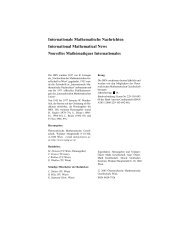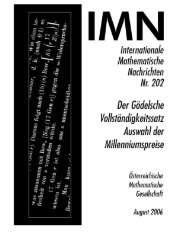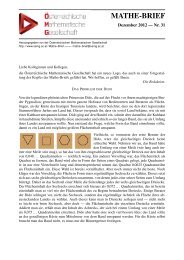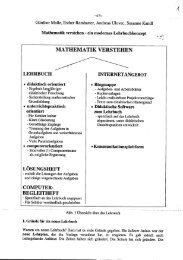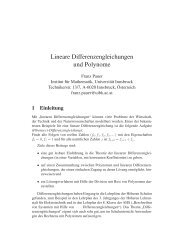218 - Ãsterreichische Mathematische Gesellschaft
218 - Ãsterreichische Mathematische Gesellschaft
218 - Ãsterreichische Mathematische Gesellschaft
Erfolgreiche ePaper selbst erstellen
Machen Sie aus Ihren PDF Publikationen ein blätterbares Flipbook mit unserer einzigartigen Google optimierten e-Paper Software.
Here H j is a term proportional to the product of j amplitudes A k and the interaction<br />
Hamiltonian H int describes nonlinear dynamics, while the quadratic Hamiltonian<br />
∞<br />
H 2 = ∑ ω k |A k | 2 (21)<br />
n=1<br />
produces a linear equation of motion,<br />
i dA k<br />
dt<br />
= ω k A k , (22)<br />
and thus describes linear waves with the dispersion function ω k ≡ ω(k). Accordingly,<br />
the term H s in (19) has the order ε s and corresponding resonance conditions<br />
in its most general form read<br />
ω 1 ± ··· ± ω s = 0,, (23)<br />
k 1 ± ··· ± k s = 0, (24)<br />
which are time and space synchronization conditions and can be interpreted as the<br />
conservation laws for energy and momentum.<br />
The problem of persistence, under perturbation, of quasi-periodic motions in<br />
Hamiltonian dynamical systems is studied in the framework of the renowned<br />
KAM theory, named after its creators Kolmogorov, Arnold and Moser in 1960th<br />
(for a comprehensive contemporary review see [16]).<br />
An important example is given by the dynamics of nearly-integrable Hamiltonian<br />
systems. In general, the phase space of a completely integrable Hamiltonian system<br />
of n degrees of freedom is foliated by invariant n-dimensional tori. KAM theory<br />
shows that, under suitable regularity and non-degeneracy assumptions, most<br />
(in measure theoretic sense) of such tori persist (slightly deformed) under small<br />
Hamiltonian perturbations.<br />
This means that if the system is subjected to a weak nonlinear perturbation, some<br />
of the invariant tori are deformed and survive, while others are destroyed. The<br />
ones that survive are those that have ‘sufficiently irrational’ frequencies, i.e. do<br />
not satisfy resonance condition (23). An important consequence of this is that for<br />
a large set of initial conditions the motion remains perpetually quasiperiodic (cf.<br />
to the Theorem on vector-field linearization discussed above).<br />
In KAM theory all results are formulated in terms of resonant and non-resonant<br />
tori but no indication is given about how to compute explicitly solutions of resonance<br />
conditions. Accordingly, the major technical problem arising in this context<br />
is due to the appearance of resonances and, consequently, of small divisors in the<br />
associated formal perturbation series.<br />
Another important issue which is not paid much attention in mathematical studies<br />
is, that for a physical system to be resonant both conditions (23), (24) should<br />
21


